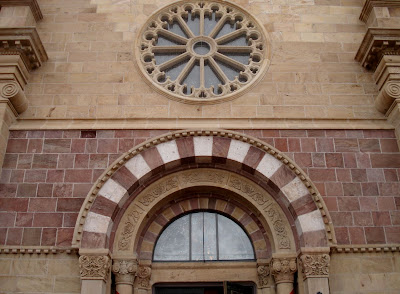
(The best single source is Floyd S. Fierman’s article The Triangle and the Tetragrammaton, which appeared in several forms. The one I consulted was from the New Mexico Historical Quarterly, v. 37, n.4, pg. 310-323, 1962.)

Many of the stories revolve around Bishop Lamy’s relationship with the Jewish community in Santa Fe, in particular with Abraham Staab. Born in Germany in 1839, Staab had emigrated in 1854, eventually arriving in Santa Fe around 1857, where he established a trading and merchandising operation throughout the southwest. By the 1870s he was a prominent businessman and in the position to lend Lamy money for the Cathedral.
Fierman wrote that the most detailed account of Staab’s connection to the symbol is from William Keleher’s The Fabulous Frontier. Keleher described how Staab had lent Lamy money for the Cathedral construction and how Staab said he would absolve all debts if he could chisel one word into the building’s entrance. Of course that word was Yahweh.
Keleher wrote that the source for his version was Staab’s son-in-law, who claimed that Staab had told this story on many occasions. In contrast, Fierman notes that Staab’s son Edward “avers under no circumstances” was there a trade of money for said carving. His father did destroy the notes, however, but “he did not bargain with the highest religious officer of the diocese.”
Continuing to seek out a reason for the symbol, Fierman wrote to Fray Angelico Chavez of the Cathedral, who had done extensive research into the history of the building. Chavez responded that the placement of the Tetragrammaton in a triangle was a common Christian symbol in Europe. It represented the holy trinity and was most likely something Lamy had seen in his youth in France. Chavez concluded “It also could be, once the emblem was carved, that these Jewish friends, totally ignorant of the triangle’s meaning, were actually pleased and did consider it a friendly gesture by Lamy! Which is all to good in this world of strife and misunderstanding among peoples.”
Nice post David, thought you might find this interesting:
What Is in a Name?
In the Hebrew language, God’s name is written יהוה. These four letters, which are read from right to left, are commonly called the Tetragrammaton. Many names of people and places mentioned in the Bible contain an abbreviated form of the divine name. Is it possible that these proper names can provide some clues as to how God’s name was pronounced?
According to George Buchanan, professor emeritus at Wesley Theological Seminary, Washington, D.C., the answer is yes. Professor Buchanan explains: “In ancient times, parents often named their children after their deities. That means that they would have pronounced their children’s names the way the deity’s name was pronounced. The Tetragrammaton was used in people’s names, and they always used the middle vowel.”
Consider a few examples of proper names found in the Bible that include a shortened form of God’s name. Jonathan, which appears as Yoh‧na‧than′ or Yehoh‧na‧than′ in the Hebrew Bible, means “Yaho or Yahowah has given,” says Professor Buchanan. The prophet Elijah’s name is ’E‧li‧yah′ or ’E‧li‧ya′hu in Hebrew. According to Professor Buchanan, the name means: “My God is Yahoo or Yahoo-wah.” Similarly, the Hebrew name for Jehoshaphat is Yehoh-sha‧phat′, meaning “Yaho has judged.”
A two-syllable pronunciation of the Tetragrammaton as “Yahweh” would not allow for the o vowel sound to exist as part of God’s name. But in the dozens of Biblical names that incorporate the divine name, this middle vowel sound appears in both the original and the shortened forms, as in Jehonathan and Jonathan. Thus, Professor Buchanan says regarding the divine name: “In no case is the vowel oo or oh omitted. The word was sometimes abbreviated as ‘Ya,’ but never as ‘Ya-weh.’ . . . When the Tetragrammaton was pronounced in one syllable it was ‘Yah’ or ‘Yo.’ When it was pronounced in three syllables it would have been ‘Yahowah’ or ‘Yahoowah.’ If it was ever abbreviated to two syllables it would have been ‘Yaho.’”—Biblical Archaeology Review.
ps
(not sure about that "my god is Yahoo" part, but I know some people who hold Google in fairly high regard.)
Terry Knouff
Hi David, just dropping by to say that I picked Stories in Stone for my "good book of the day" today.
I really love the book, especially both my parents come from stoneworking families (different stones, different parts of the country). *Someone* is getting it as a present, I just don't know who, yet.
The one thing I really missed in the book was a good set of pictures. I see some of them — like the Morton gneiss — are on this blog, but it would be nice if you could link them into a table of contents or something, so readers could see detailed, colorful images as they read.
Dr. Science,
Thanks for your note and for your recommendation. I, too, wish there had been more photos, maps, and drawings, but alas money was an issue in publication. Perhaps in the paperback edition.
Cheers,
David
Great research job — always fun to follow you down rabbit holes, especially ones lined with stone.